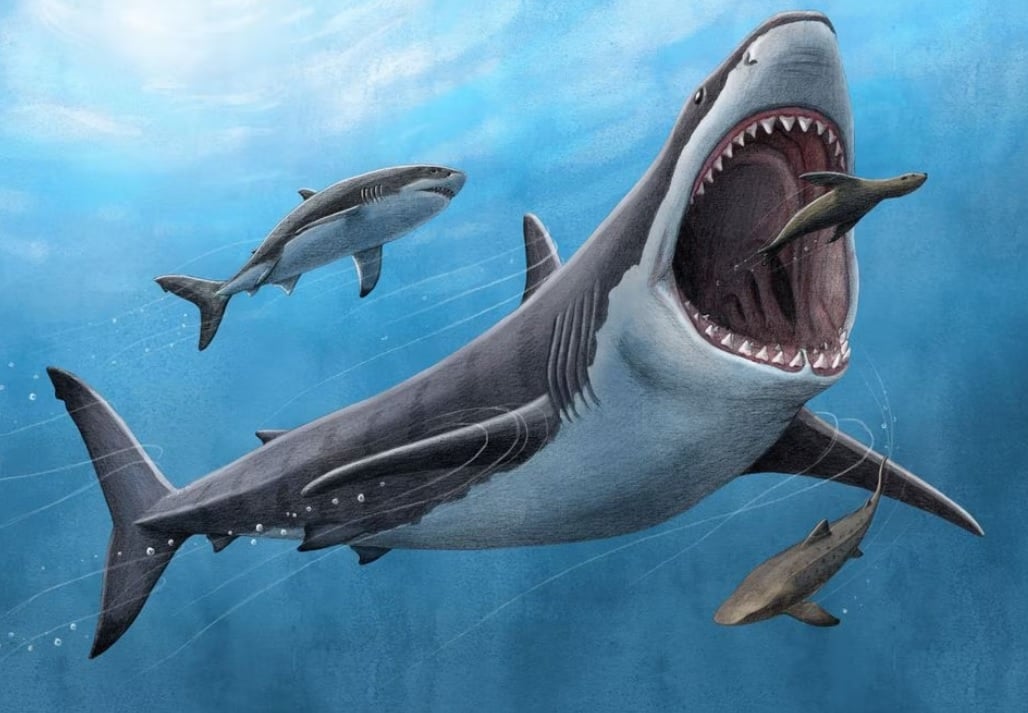According to a study published last week in the journal Proceedings of the National Academy of Sciences , scientists have discovered through analysis of fossilized Megalodon teeth that this extinct shark was partially warm-blooded. Megalodon's body temperature was about 7 degrees Celsius higher than the estimated sea temperature at the time, according to CNN.
“We found that Otodus megalodon had a significantly higher body temperature than other sharks, consistent with its having a similar level of internal heat production to modern warm-blooded animals,” study co-author Robert Eagle, a professor of marine sciences and biogeography at UCLA, said in an email. The findings suggest that this distinctive trait played a key role in the ancient predator’s fearsome size and may explain its extinction.
Illustration of a Megalodon shark about to swallow a seal. Photo: Reuters
At least 15 metres long, Otodus megalodon, also known as the megatooth shark, was one of the largest predators in the sea since the Mesozoic Era and went extinct about 3.6 million years ago.
Previously, scientists hypothesized that Megalodon was warm-blooded, but this new study is the first to provide concrete evidence for this hypothesis.
The researchers found that the carbon-13 and oxygen-18 isotopes in the fossilized teeth of this ancient shark were closely aligned, a data point that can reveal how warm the body was. From this finding, they inferred that the average body temperature of Megalodon was around 27 degrees Celsius.
Like modern great whites and mako sharks, Megalodon was endothermic, meaning it was able to regulate the temperature of certain parts of its body, according to the study. In contrast, the body temperature of other cold-blooded predators depends on the temperature of the water around them.
Warm-bloodedness may have been one of the main drivers of the shark's enormous size and powerful hunting abilities, according to senior study author Kenshu Shimada, a paleontologist at DePaul University in Chicago.
“A large body size increases the efficiency of catching prey over a larger spatial range, but it requires a lot of energy to maintain,” Shimada said in an email. “Based on the fossil record, we know that Megalodon had giant cutting teeth that were used to feed on marine mammals, such as pinnipeds and cetaceans. The new study is consistent with the idea that the evolution of warm-bloodedness was the main reason for Megalodon’s giant size to keep up with its high metabolic demands.”
For such a large animal, the constant use of so much energy to regulate its body temperature may have contributed to its decline as the world changed. Researchers say the Megalodon's extinction coincided with a cooling of the Earth's temperature.
“The disappearance of Megalodon shows the vulnerability of warm-blooded animals, which require a constant supply of food to maintain their high metabolism,” Shimada said. “There may have been a change in the marine ecosystem due to the cooling climate.” The cooling climate caused sea levels to drop, altering the habitat of the populations of Megalodon’s food sources, such as marine mammals, and leading to the species’ extinction.
Compared to other apex predators, Megalodon was much larger and therefore more vulnerable to changes in prey populations, said Michael Griffiths, lead author of the study and a paleontologist at William Paterson University in New Jersey.
Learning more about this ancient shark could help scientists better understand the threats facing similar marine animals today. “One of the big implications of this study is that it highlights that large predators, like modern great white sharks, are vulnerable to climate change because of their biological similarities to Megalodon,” said Griffiths.
According to VNA/Tin Tuc Newspaper
Source link




![[Photo] Opening ceremony of "Digital Citizenship - Digital School" and commitment to civilized behavior in cyberspace](https://vphoto.vietnam.vn/thumb/1200x675/vietnam/resource/IMAGE/2025/9/5/222ec3b8892f443c9b26637ef2dd2b09)


![[Photo] Hanoi students excitedly and joyfully open the new school year 2025-2026](https://vphoto.vietnam.vn/thumb/1200x675/vietnam/resource/IMAGE/2025/9/5/ecc91eddd50a467aa7670463f7b142f5)
![[Photo] The drum beats to open the new school year in a special way](https://vphoto.vietnam.vn/thumb/1200x675/vietnam/resource/IMAGE/2025/9/5/b34123487ad34079a9688f344dc19148)























































































Comment (0)